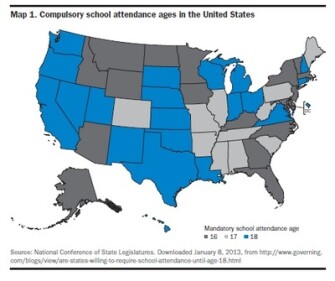
Eleven states raised their compulsory school attendance ages between 2002 and 2011 in hopes of reducing dropout and discipline rates, but none of them followed through with studies to determine if the policies were actually effective, a study by the National Center for Education Evaluation and Regional Assistance found.
“The evidence for raising the compulsory school attendance age is inconclusive, so no clear policy implications can be drawn,” says the report, released Wednesday.
But a review of other materials suggests that states that adopt higher attendance age requirements “should do so in conjunction with complementary retention and dropout-prevention policies that create a comprehensive approach,” the report says.
As Maryland increases its compulsory school attendance age in two stages, researchers recommend a controlled study of the policy’s results to inform discussions elsewhere. Under a law passed in 2012, Maryland’s attendance age is set to increase from 16 to 17 at the beginning of the 2014-15 school year and from 17 to 18 at the beginning of the 2016-17 school year.
Maryland will join the eleven states who passed similar laws between 2002 and 2011: Alabama, Colorado, Illinois, Indiana, Michigan, Nebraska, Nevada, New Hampshire, Rhode Island, South Dakota, and West Virginia. Says the study:
The chief arguments favoring the change are that it will reduce dropout rates, signal to children and their families that dropping out is unacceptable, and more than compensate for the higher costs of educating students longer through lower spending on social programs, public safety, correctional services, and other state programs and functions. Arguments against increasing the age are that costs will rise, that requiring older teens to remain in schools against their will causes disciplinary and safety problems for other students, and that doing so usurps parents' rights to make education decisions for their children."
But state lawmakers’ “interest wanes” in the policies after they greenlight them, the study said, and few make any effort to determine if they should revise or remove the new rules to make them more effective.
And many national studies use outdated data or present conflicting conclusions, the report says:
Neither proponents nor opponents of raising the compulsory school attendance age are on firm empirical ground. It is difficult to draw any policy implications from the mixed findings of the research literature on the merits of increasing the compulsory school attendance age."
The national report came a day after West Virginia State Superintendent James Phares told a legislative panel the state’s decision to raise its attendance age from 16 to 17 has “made a significant difference” in slowing the state’s dropout rate. But it’s too soon to tell for sure that the policy is having the intended effects, the Associated Press reported.
The national study recommends that Maryland track a list of data points as it raises its required attendance age, including data on: truancy; bullying, harassment, or intimidation; referrals to alternative education options; suspensions; and expulsions.
What do you say, Maryland?
